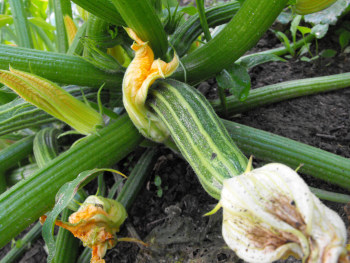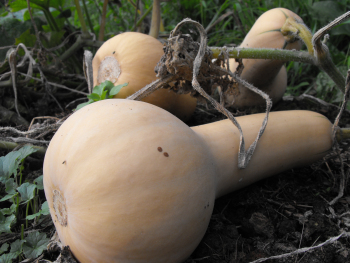
Cucurbit Species
 Cucurbits (squashes, pumpkins, cucumbers, and
melons) are a bit more difficult seed-saving candidates than peas and
beans because cucurbits hybridize readily. If you're careful,
though, they can be on your easy seed-saving list.
Cucurbits (squashes, pumpkins, cucumbers, and
melons) are a bit more difficult seed-saving candidates than peas and
beans because cucurbits hybridize readily. If you're careful,
though, they can be on your easy seed-saving list.
The trick to saving cucurbit seeds is understanding which varieties are
related. If you haven't had biology in a while, now's the time to
remember that any individuals within the same species can interbreed,
while individuals of different species mostly can't interbreed.
(That, after all, is the definition of a species.) So, if you
only grow one variety in each cucurbit species, you're pretty much home
free.
 Some species are simple --- cucumbers are all
in the same species (Cucumis sativus)
while most melons are in a related but distinct species (Cucumis melo.) Watermelons
are in their own species --- Citrillus
vulgaris. So, if you want to save cucumber seeds, plan to
only grow one variety of cucumber in your garden. Same with
melons, though you can grow watermelons and canteloupes side by side
with no problems since they're in different species. If you want
to save seeds from two different kinds of watermelons, you need to
either separate the plants by at least half a mile (hah!), or cover the
flowers with a bag before they open and hand-pollinate them. That
clearly goes beyond our easy seed-saving mentality.
Some species are simple --- cucumbers are all
in the same species (Cucumis sativus)
while most melons are in a related but distinct species (Cucumis melo.) Watermelons
are in their own species --- Citrillus
vulgaris. So, if you want to save cucumber seeds, plan to
only grow one variety of cucumber in your garden. Same with
melons, though you can grow watermelons and canteloupes side by side
with no problems since they're in different species. If you want
to save seeds from two different kinds of watermelons, you need to
either separate the plants by at least half a mile (hah!), or cover the
flowers with a bag before they open and hand-pollinate them. That
clearly goes beyond our easy seed-saving mentality.
How about
squashes? That's where the taxonomy gets messy. Even though
gardeners divide squashes up into winter and summer squash, there are
actually four species which cover the vegetables we call squashes:
- Cucurbita pepo --- all summer squashes (zucchini, yellow squashes, etc.), some varieties of pumpkins, and pattypan, spaghetti, delicata, and acorn squash
- Cucurbita moschata --- butternut squash
- Cucurbita mixta --- cushaw, some pumpkins
- Cucurbita maxima ---
kabocha squash, some pumpkins
Now, if, like me, you've
decided that the only winter squash worth growing is butternut, you can
save your seeds with no problems since butternuts are in their own
species. However, if you want to save summer squash seed, you
should plan to grow only one variety and to delete the other members of
that species from your garden (and from your neighbor's garden if they
live within half a mile.)
| This post is part of our Seed Saving lunchtime series.
Read all of the entries: |
Want more in-depth information? Browse through our books.
Or explore more posts by date or by subject.
About us: Anna Hess and Mark Hamilton spent over a decade living self-sufficiently in the mountains of Virginia before moving north to start over from scratch in the foothills of Ohio. They've experimented with permaculture, no-till gardening, trailersteading, home-based microbusinesses and much more, writing about their adventures in both blogs and books.
Want to be notified when new comments are posted on this page? Click on the RSS button after you add a comment to subscribe to the comment feed, or simply check the box beside "email replies to me" while writing your comment.
- Remove comment
- Remove comment
